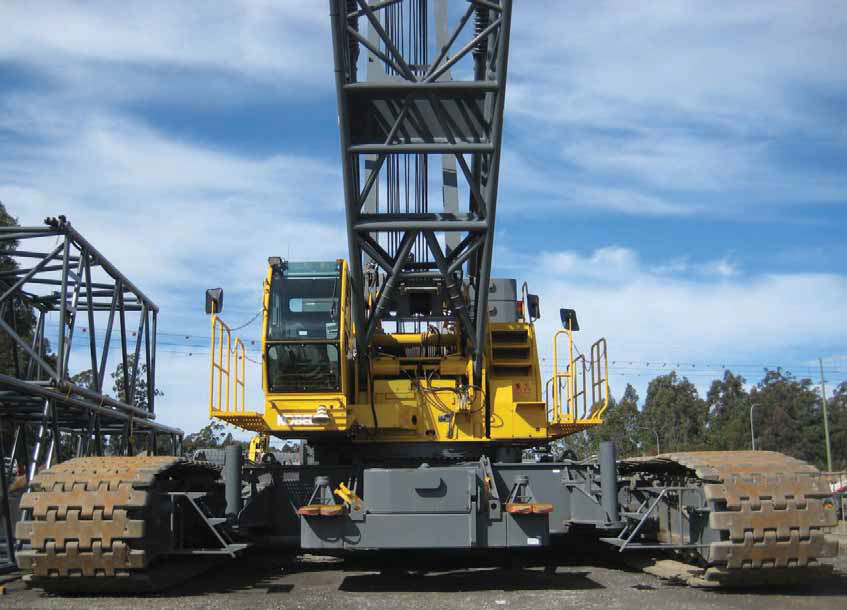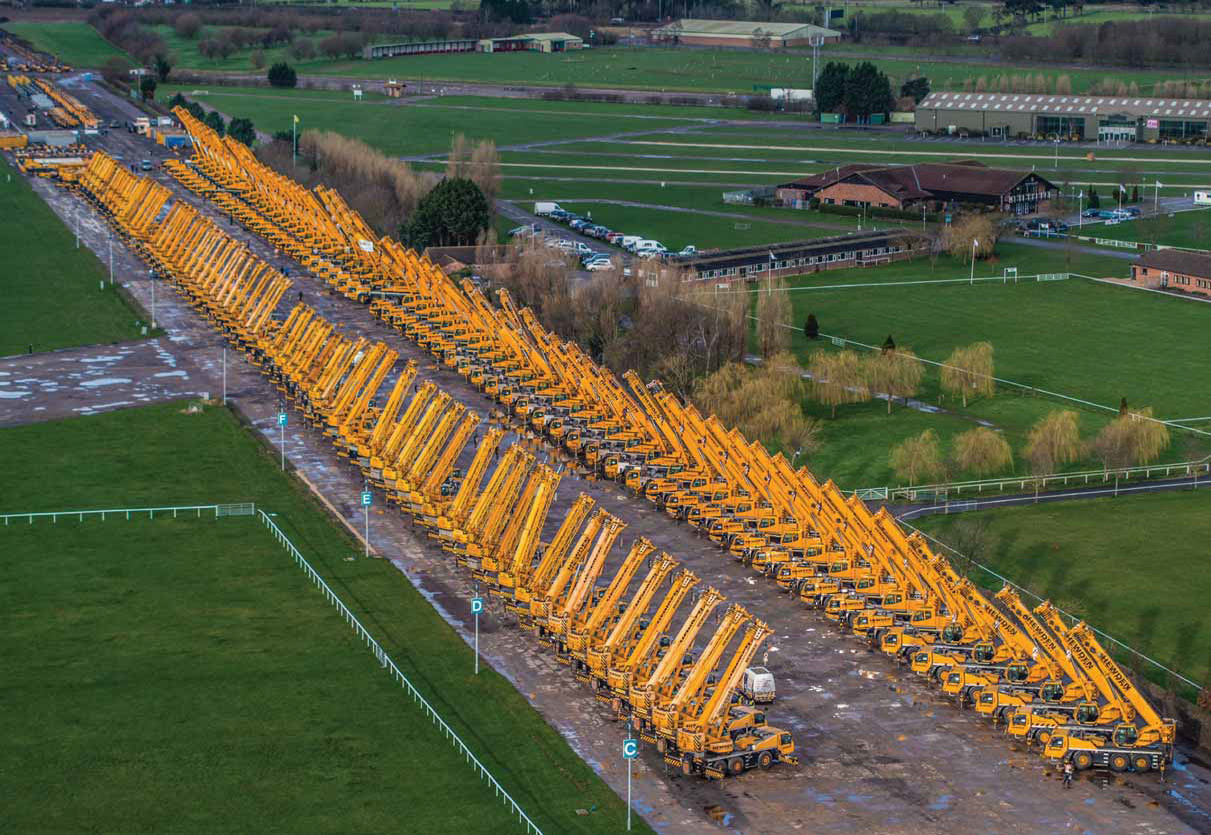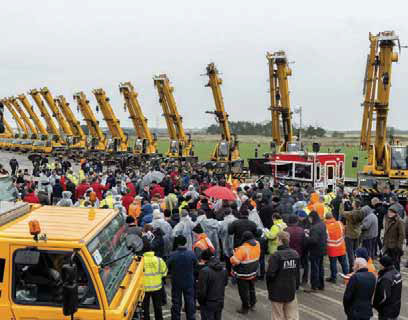Pre-owned, pre-loved, still valuable
17 May 2018The market in second-hand cranes is buoyant. We investigate the regions that want them and the types that sell well.
Cranes, unlike cars, do not depreciate quickly: most cranes, if well-maintained, will hold their value very well. The market in used cranes is worldwide: a crane for sale in America may well find a buyer in Africa or the Middle East or South-east Asia. These two factors together shape the market in second-hand cranes.
The first factor, the lack of depreciation, means that a crane owner can buy a new crane using financing, use the machine for six to ten years according to his business philosophy while covering the interest payments on it, then sell the crane and repay most of the capital on the initial loan. The economics of the proceeding make obvious sense. No great capital expenditure is involved at any stage.
The second factor, the global nature of the market, means that such sold-on cranes may pass through two or three companies in their initial market before being sold onto secondary markets around the world: European cranes often end up in the Middle East and Africa, US cranes in South America, Japanese cranes in Asia.
Terex has a division for selling on used cranes on behalf of their customers. Sascha Reischmann, their manager for used cranes, amplifies the above global point.
“Generally, cranes are coming from Europe” he says, “but also from North and South America, India and East Asia. The strongest markets for selling used cranes at the moment are Europe, North America, India, Northern Africa and Australia.”
That global nature was shown by an auction that Euro Auctions held in Norfolk last year. The sale was of the assets of Hewdens, which had gone into liquidation.
127 units were sold, all on the same day—which made it, says Euro Auctions commercial manager Jonnie Keys, the largest single sale of used cranes ever. 500 bidders were present in person, and 1,500 more registered and took part via the internet; 15% of all the winning bids went to on-line bidders. 36 of the cranes were bought by UK companies, the remainder went to bidders from over 30 different countries.
One bidder from Holland, for example, represented a Kuwait purchaser and bought a package of eight cranes. Other notable bids were from as far afield as the Netherlands, Finland, Oman, Chile and Japan.
The largest items sold were two 220t Tadano all terrain cranes, which went for £725,000 (€877,500) each, which was the largest single ticket item that Euro Auctions had ever achieved for used pieces of equipment.
Different areas of the world are in different stages of their economic cycles, from expansion to recession, and demand for cranes tends to follow the building booms.
Thus it is that Keys can point to a currently-large source- and end-point: “Dubai to Europe is still buoyant” he says – and explains why.
“Dubai has been building an awful lot of stuff. But two years ago many of the construction projects there were put on hold. Two schools of practice followed: some contractors parked up their equipment, waiting for their project to re-start or another to take its place; other contractors said ‘I will cash in my crane assets, and maybe buy back later if I need it.’
“Some overseas cranes are classified ‘not for use in Europe’” he says “because of emissions or safety issues. But if a piece of kit is in demand, given the state of the euro a Europe-legal crane can usually find a higher price in Europe or from a European buyer.
Some types of cranes are in more demand than others. “We are noticing a strong demand for all terrain cranes just now, especially for three- to five-axle all terrain cranes” said Reischmann of Terex.“The reason is that currently there is a strong demand worldwide for new cranes of these types; the consequences are longer lead times for new cranes, from the order to the crane handover, and so some customers are turning to the secondhand market for quicker delivery.”
“Euro Auction usually come across mobile cranes rather than [tower cranes],” confirms Keys. Mobiles account for around half of all cranes in use by type; demand for used mobiles remains high, says Jonnie Keys, Euro Auctions’ operations . Euro Auction’s analysis suggests that growth of around 5% in mobile unit terms is expected over the next ten years, based on construction sector improvements and general market conditions, the key markets being widely regarded as China, Europe, Japan, India and North America.
“There is traditionally less of a market in used tower cranes” says Keys. “An owner buys a brand new one; after he has extracted full use from it he scraps it and buys another, quite often a bigger one. So the number of tower cranes remains fairly static; but the total capacity of tower cranes in the world is getting larger.”
Business is booming: “Over the last nine months, since July 2017, 60 pieces have come through. It seems a constant two or three here and there. Capacities mostly range from 50t or 100t down to quite a lot of 15t capacity mobiles. The really big stuff, of 1,200t and up, are rare beasts with rarified markets. Those tend to change hands back via the manufacturer or private sales.”
Which Keys confirms: “The global heavy ‘hook’ crane and lifting sector remains quite small in terms of manufacturers, key operators, and equipment deployed or available; and it is an extremely tight-knitted global market and community.”
“Used machines around the 250t mark are in extremely high demand and retain high residual values” says Keys, “which means that these also go via private sale, where buyers directly liaise with current owners.”
In the last nine months Euro Auctions has auctioned over 60 heavy lift units around the world.
Top prices— of between £75,000 and £101,000—were achieved by a number of 50t units sold in Dubai, with many remaining in the region—projects would seem to be viewed as re-starting or about to re-start. A 75t unit sold for £77,000 in Hong Kong to a buyer in Singapore; whilst a 100t crawler crane changed hands for £32,000 in the September auction in Dormagen. A number of 25t units also changed hands for around just under the £50,000 mark. At the other end of the spectrum a 16t unit sold in Leeds for just £3,500.
From on-site to online
Ritchie Bros was founded as a small family company in 1958 selling heavy equipment and trucks.
“For many years the policy was to sell at live auctions—often at the sellers premises—with no reserve prices” says Jacobo Garcia, in charge of developing the EMEA area.
“That business model lasted for many years, until the 1990s.” In 2017 the company merged with online marketplace Iron Planet. “That was a huge game-changer for buyers and for sellers,” he says.
“The unreserved on-site auctions still continue, but we now offer two other ways to buy and sell.”
One is the on-line auction, held weekly; the other is what they call marketplace-E, which is a reserved on-line marketplace which functions in much the same way as eBay.
Potential buyers can enter an auction with a time-limit; or they can opt to pay a full price to purchase the item immediately.
“Becoming a multi-channel marketplace widens the horizon: it gives flexibility for the customers, who can choose according to their needs for a quick purchase or for a potentially lower price.”
He says that prices gained tend to be very similar whether or not a reserve is set; “but adding a reserve price does give sellers more confidence.”
“The used market is good, especially for all-terrain cranes” Garcia adds. “Last year prices were stable, but now fewer cranes are coming onto the market, which is good for all concerned as it is tending to push prices up. It is evidence that many countries are coming out of the very long economic crisis.”
Ritchie Bros sells globally. Different countries have different demands. “Spain is wanting 50–100t machines for general construction, and the market is picking up there, as it is in Italy. In Germany, the Netherlands, Holland and the UK the market is always good, so buying and selling tends to happen internally.
“In general, all terrains from 30t to 100t have always been in demand; for bigger units, of 300- 400t there are fewer units available.
Crawlers seem to be less in demand at the moment. There is really no market for tower cranes. One reason is that transporting them is difficult.”
“As for age, the oldest tend to be around 10 to 12 years old, but quite new cranes, built in 2012 or 2014, also come onto the market. German owners tend to change their cranes more frequently than Italian owners, and their internal market is stronger in terms of pricing. Cranes from 50t to 100t work every day, so accumulate more hours on the clock; larger cranes work fewer hours, and that affects reselling values.
Secondhand south
The Australasian market demonstrates the same two guiding factors, as modified by its own special circumstances. It has the same or higher regulatory standards as other developed markets, but is far away from most manufacturing plants. In the past this has driven a demand for ‘nearly new’ premium cranes from markets like Japan.
But times have been changing. Australian Crane and Machinery has been offering a used crane service for 25 years. Sales manager Justin Potter explains the current situation.
After many years of downturn, the market is starting to take off again. “Lots of things are happening in Australia. We have been really, really busy” he says.
“Melbourne, where we are based, is now the most rapidly-growing city in the world. When I first came here it had 2.5 million people; by the end of the year it is expected to be 5 million. There has been a huge growth in roads and rail and construction. Infrastructure spend has now overtaken mining spend in Australia, something that has not been the case for 20 years.”
This of course has benefited the used crane market. The recession that followed the financial crash of 2008 hit Australia hard. “Many cranes were mothballed, or put onto a stagnant market because there was simply no use for them” says Potter. The parallel with Dubai is clear. “Now, though, used cranes are being retained and put to use.”
It has been helped by the fact that the Australian regulatory authorities have relaxed their ten year inspection programme. “They have realised that classifying a crane by age alone, which is what they used to do, is inappropriate” says Potter. “What matters is the maintenance that the crane has received through its working life.
That recognition has reduced the major rebuilds that were previously needed on older cranes—and that in turn takes the costs down, both of the inspections and of the cranes.
So we are selling used cranes now, at the rate of about two a month. Some years ago we were selling at the rate of two a week, but that was before the recession.” And Australia is no exception to the global nature of the market. “Examples of recent sales are a 100t crawler from New Zealand that went to Chittagong in Bangladesh. And we have sold a Japanese hydraulic truck crane, built in the 90s, to the Middle East - hydraulic truck cranes are very popular there.
And a used Chinese truck crane has gone back to South-east Asia. Business is looking good just now. Manufacturers and representatives are doing well. The used crane business here and in New Zealand is shooting up because usage is shooting up. Historically 100 to 200 new mobiles would be imported into Australia and New Zealand each year; we are now seeing 300 new rubber-tyre cranes a year into Australia alone.”
Despite our remarks about the global market, local conditions do have their effect, at least on the types of crane that are wanted.
“The crawler crane market is a bit slow here,” says Potter. There is a reason: “The big McAleese group went into administration in 2015/2016. Among its companies were Walter Wright cranes and National Cranes. The result was that their assets in cranes—and they had a lot—were sold off. Not many of them went overseas. 25 large lattice cranes were consumed by the Australian market. We did sell a few of them to New Zealand.
They also dropped close to 200 rubber-tyred Franna Terex cranes, which has made it hard for the used cranes market over the past two years.”
“But the market for used cranes is very strong now, thanks to that infrastructure growth. It is exciting.”


